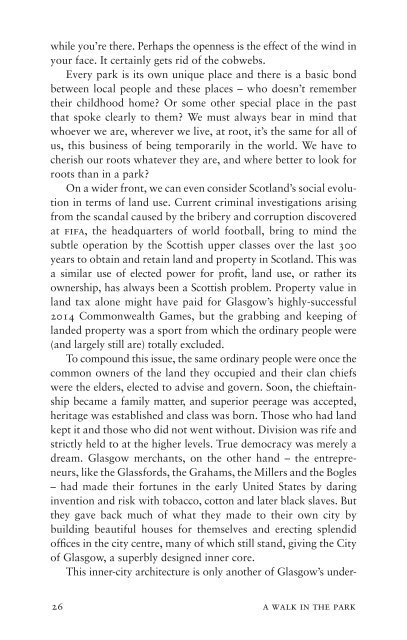A Walk in the Park by John Cairney sampler
A wander through twelve of Glasgow’s finest parks, and through the mind of a treasured Glasgow resident, John Cairney. Cairney’s exploration of his home city’s dear green places ranges from Tollcross Park in the east, to the Botanic Gardens, pride of the West End, and even right out to Hogganfield Loch in the city’s furthest reaches. Written with a deep love of the city, A Walk in the Park takes us on a journey into Glasgow’s past as well as through its outdoor spaces. Cairney traces his city’s history back a millennium to its founding by that great wanderer, St Mungo. Through the stories of its parks Glasgow comes to life, a post-industrial city with an unmatched individuality, a thriving cultural scene, and a lot to look forward to.
A wander through twelve of Glasgow’s finest parks, and through the mind of a treasured Glasgow resident, John Cairney. Cairney’s exploration of his home city’s dear green places ranges from Tollcross Park in the east, to the Botanic Gardens, pride of the West End, and even right out to Hogganfield Loch in the city’s furthest reaches.
Written with a deep love of the city, A Walk in the Park takes us on a journey into Glasgow’s past as well as through its outdoor spaces. Cairney traces his city’s history back a millennium to its founding by that great wanderer, St Mungo. Through the stories of its parks Glasgow comes to life, a post-industrial city with an unmatched individuality, a thriving cultural scene, and a lot to look forward to.
You also want an ePaper? Increase the reach of your titles
YUMPU automatically turns print PDFs into web optimized ePapers that Google loves.
while you’re <strong>the</strong>re. Perhaps <strong>the</strong> openness is <strong>the</strong> effect of <strong>the</strong> w<strong>in</strong>d <strong>in</strong><br />
your face. It certa<strong>in</strong>ly gets rid of <strong>the</strong> cobwebs.<br />
Every park is its own unique place and <strong>the</strong>re is a basic bond<br />
between local people and <strong>the</strong>se places – who doesn’t remember<br />
<strong>the</strong>ir childhood home? Or some o<strong>the</strong>r special place <strong>in</strong> <strong>the</strong> past<br />
that spoke clearly to <strong>the</strong>m? We must always bear <strong>in</strong> m<strong>in</strong>d that<br />
whoever we are, wherever we live, at root, it’s <strong>the</strong> same for all of<br />
us, this bus<strong>in</strong>ess of be<strong>in</strong>g temporarily <strong>in</strong> <strong>the</strong> world. We have to<br />
cherish our roots whatever <strong>the</strong>y are, and where better to look for<br />
roots than <strong>in</strong> a park?<br />
On a wider front, we can even consider Scotland’s social evolution<br />
<strong>in</strong> terms of land use. Current crim<strong>in</strong>al <strong>in</strong>vestigations aris<strong>in</strong>g<br />
from <strong>the</strong> scandal caused <strong>by</strong> <strong>the</strong> bribery and corruption discovered<br />
at fifa, <strong>the</strong> headquarters of world football, br<strong>in</strong>g to m<strong>in</strong>d <strong>the</strong><br />
subtle operation <strong>by</strong> <strong>the</strong> Scottish upper classes over <strong>the</strong> last 300<br />
years to obta<strong>in</strong> and reta<strong>in</strong> land and property <strong>in</strong> Scotland. This was<br />
a similar use of elected power for profit, land use, or ra<strong>the</strong>r its<br />
ownership, has always been a Scottish problem. Property value <strong>in</strong><br />
land tax alone might have paid for Glasgow’s highly-successful<br />
2014 Commonwealth Games, but <strong>the</strong> grabb<strong>in</strong>g and keep<strong>in</strong>g of<br />
landed property was a sport from which <strong>the</strong> ord<strong>in</strong>ary people were<br />
(and largely still are) totally excluded.<br />
To compound this issue, <strong>the</strong> same ord<strong>in</strong>ary people were once <strong>the</strong><br />
common owners of <strong>the</strong> land <strong>the</strong>y occupied and <strong>the</strong>ir clan chiefs<br />
were <strong>the</strong> elders, elected to advise and govern. Soon, <strong>the</strong> chiefta<strong>in</strong>ship<br />
became a family matter, and superior peerage was accepted,<br />
heritage was established and class was born. Those who had land<br />
kept it and those who did not went without. Division was rife and<br />
strictly held to at <strong>the</strong> higher levels. True democracy was merely a<br />
dream. Glasgow merchants, on <strong>the</strong> o<strong>the</strong>r hand – <strong>the</strong> entrepreneurs,<br />
like <strong>the</strong> Glassfords, <strong>the</strong> Grahams, <strong>the</strong> Millers and <strong>the</strong> Bogles<br />
– had made <strong>the</strong>ir fortunes <strong>in</strong> <strong>the</strong> early United States <strong>by</strong> dar<strong>in</strong>g<br />
<strong>in</strong>vention and risk with tobacco, cotton and later black slaves. But<br />
<strong>the</strong>y gave back much of what <strong>the</strong>y made to <strong>the</strong>ir own city <strong>by</strong><br />
build<strong>in</strong>g beautiful houses for <strong>the</strong>mselves and erect<strong>in</strong>g splendid<br />
offices <strong>in</strong> <strong>the</strong> city centre, many of which still stand, giv<strong>in</strong>g <strong>the</strong> City<br />
of Glasgow, a superbly designed <strong>in</strong>ner core.<br />
This <strong>in</strong>ner-city architecture is only ano<strong>the</strong>r of Glasgow’s under -<br />
26 a walk <strong>in</strong> <strong>the</strong> park


















